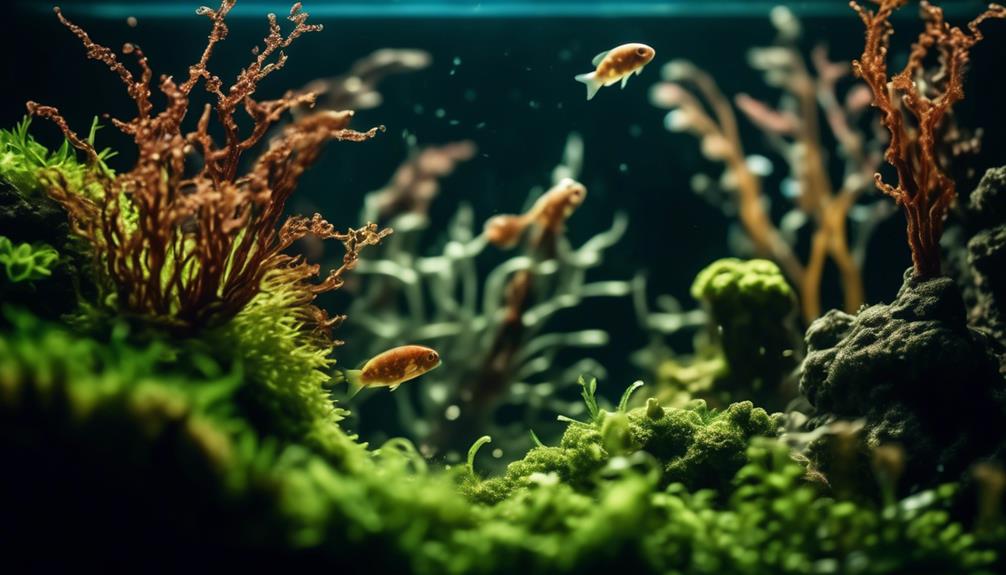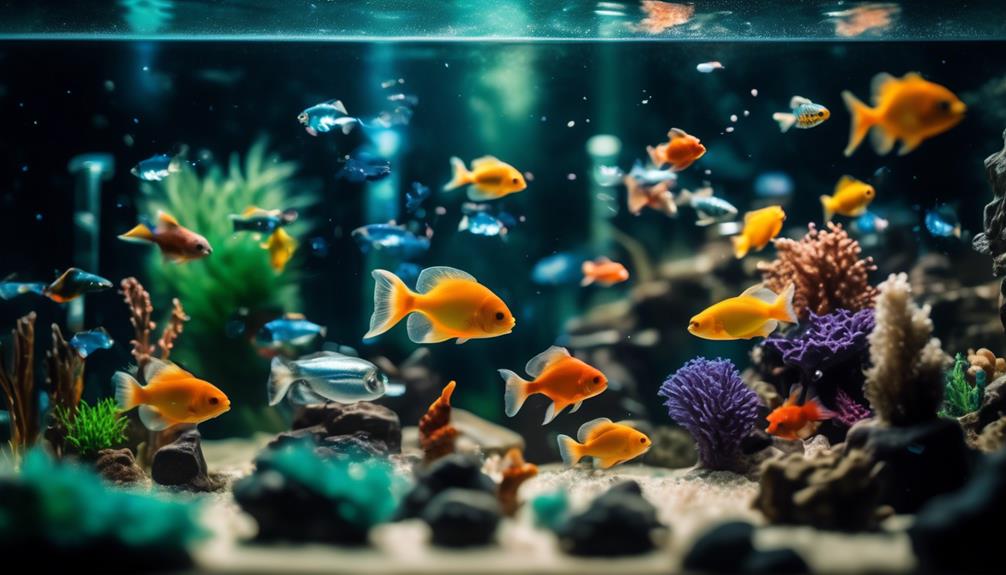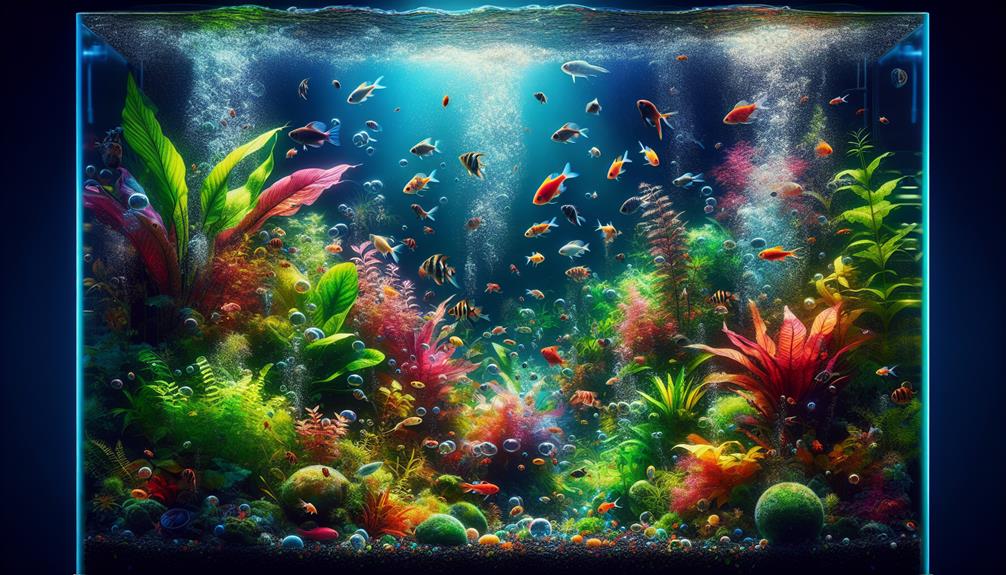Welcome to the fascinating world of aquarium secrets, where the hidden intricacies of the nitrogen cycle are about to be unveiled.
Within the confines of your aquarium, a complex web of processes is at play, silently transforming fish waste into potentially harmful nitrogen compounds. But fear not, for the key to maintaining a healthy aquatic ecosystem lies in understanding and harnessing the power of beneficial bacteria.
In this discussion, we will shine a light on the crucial role these microscopic organisms play in breaking down ammonia, nitrites, and nitrates, ensuring the well-being of your aquatic companions.
But the nitrogen cycle holds more than just bacteria – we will also explore the duration and monitoring of aquarium cycling, uncover strategies for increasing biological filtration, and provide you with access to our valuable resources and expert advice.
So, join us as we untangle the secrets of the nitrogen cycle and embark on a journey towards a thriving aquarium haven.
Key Takeaways
- The nitrogen cycle in aquariums is a natural process that converts fish waste into toxic nitrogen compounds.
- Beneficial bacteria play a crucial role in breaking down ammonia into nitrites, and nitrites into nitrates.
- High levels of nitrates can harm fish, so it is important to remove them through water changes or the use of aquarium plants.
- Monitoring ammonia, nitrites, and nitrates levels is essential to determine if the aquarium is properly cycled.
Understanding the Nitrogen Cycle
The nitrogen cycle is a fundamental process in aquariums that involves the conversion of fish waste into toxic nitrogen compounds and the subsequent breakdown of these compounds by beneficial bacteria.
This cycle is crucial for maintaining water quality and the overall health of the aquarium ecosystem.
Beneficial bacteria play a vital role in this process as they consume ammonia, produced by fish waste, and convert it into nitrites.
Another type of beneficial bacteria then consumes nitrites and converts them into nitrates. High levels of nitrates can be harmful to fish and can lead to health problems.
To prevent high nitrate levels, regular water changes should be conducted to remove excess nitrates. Additionally, incorporating aquarium plants can help in reducing nitrate levels, as they consume nitrates as a nutrient source.
The presence of beneficial bacteria and proper maintenance of water parameters are essential for maintaining a healthy nitrogen cycle in aquariums.
Duration and Monitoring of Aquarium Cycling
In order to fully understand and maintain the nitrogen cycle in an aquarium, it is important to consider the duration of the cycling process and the necessary monitoring to ensure its effectiveness. Here are some key points to consider:
- Benefits of live nitrifying bacteria: Live nitrifying bacteria play a crucial role in the nitrogen cycle by converting toxic ammonia into nitrites and then into nitrates. Adding these bacteria to the aquarium can help speed up the cycling process and establish a stable biological filtration system.
- Role of aquarium plants in cycling: Aquarium plants play a vital role in the nitrogen cycle by absorbing nitrates as a nutrient source. They help reduce the levels of nitrates in the water, which can be harmful to fish if present in high concentrations. Incorporating live plants in the aquarium not only enhances the aesthetic appeal but also contributes to a healthier nitrogen cycle.
- Monitoring ammonia, nitrites, and nitrates levels: Regular monitoring of ammonia, nitrites, and nitrates levels is essential to determine the progress of the cycling process. Test kits are available to measure these parameters accurately. Monitoring allows for timely intervention, such as water changes or adjustments to the biological filtration, to maintain optimal water quality for the fish.
- Duration of cycling process: The duration of the cycling process can vary, typically taking a few weeks to months. Factors such as the presence of live nitrifying bacteria, the use of used filter media, and the introduction of live plants can accelerate the cycling process. Patience is key, as rushing the process can lead to imbalances and issues with water quality.
Increasing Biological Filtration

To enhance the efficiency of the aquarium's biological filtration system, incorporating additional surfaces for beneficial bacteria colonization is recommended. These surfaces provide a larger area for the bacteria to grow and thrive, allowing for better conversion of harmful nitrogen compounds. One way to increase biological filtration is by adding more filtration media, such as ceramic rings or bio balls, to the filter. These materials have a porous structure that provides ample space for bacterial colonization. Another option is to include decorations, such as rocks or driftwood, in the aquarium. These objects not only add aesthetic value but also provide additional surfaces for beneficial bacteria to colonize. Additionally, having live plants in the aquarium can further enhance biological filtration by absorbing ammonia and nitrates as a source of nutrients. It is important to note that while increasing biological filtration is beneficial, regular water changes are still essential for maintaining water quality and removing excess nitrates.
| Increasing Biological Filtration | ||
|---|---|---|
| Option 1: Filtration Media | Option 2: Decorations | Option 3: Live Plants |
| – Ceramic rings<br>- Bio balls | – Rocks<br>- Driftwood | – Aquatic plants<br>- Moss balls |
| – Provides a porous structure for bacterial colonization<br>- Increases surface area for beneficial bacteria | – Adds aesthetic value to the aquarium<br>- Provides additional surfaces for bacterial colonization | – Absorbs ammonia and nitrates as a nutrient source<br>- Enhances overall water quality |
| – Enhances the capacity for biological filtration<br>- Promotes the conversion of harmful nitrogen compounds | – Creates more opportunities for beneficial bacteria colonization<br>- Supports a healthy nitrogen cycle | – Improves water quality by reducing ammonia and nitrates<br>- Adds natural beauty to the aquarium |
Subscription and Recent Blog Posts
Continuing our exploration of aquarium knowledge, let's now shift our focus to the world of subscriptions and recent blog posts, where you can stay up-to-date with the latest information and insights on aquarium-related topics.
- Benefits of regular water changes: Subscribing to a blog allows you to receive valuable information on the benefits of regular water changes. Water changes help maintain water quality by removing excess nitrates and other harmful substances that can accumulate over time. By staying informed through blog posts, you can learn about the proper techniques and frequency of water changes to keep your aquarium inhabitants healthy.
- Importance of monitoring water parameters: The blog posts can also provide guidance on the importance of monitoring water parameters such as ammonia, nitrites, and nitrates. Regular monitoring allows you to detect any imbalances or fluctuations in these parameters, which can be detrimental to the well-being of your aquatic pets. By subscribing to the blog, you can access tips and tricks for accurate testing and learn how to interpret the results to make necessary adjustments to maintain optimal water conditions.
- Stay updated on the latest aquarium-related content: Subscribing to the blog ensures that you receive regular updates on the latest aquarium-related content. This includes topics such as care guides for specific fish species, tips on maintaining a healthy aquatic environment, and information on new products and techniques. By staying updated, you can stay ahead of the curve and provide the best care for your aquarium inhabitants.
- Explore a variety of aquarium topics: The blog offers a diverse range of articles, covering various aspects of the aquarium hobby. From fish species profiles to breeding guides and algae control methods, the blog provides a wealth of information to enhance your understanding and enjoyment of aquarium keeping. By subscribing, you can explore a wide range of topics that cater to your specific interests and needs.
Featured Products and Resources

Discover a range of featured products and resources that are designed to enhance your freshwater aquarium experience. Take advantage of the Easy Guide to Water Changes, which provides comprehensive information on maintaining water quality in your aquarium. This invaluable resource will guide you through the process of performing water changes, ensuring that your fish and plants thrive in a clean and healthy environment. Additionally, explore the benefits of using Easy Green, an all-in-one fertilizer specifically formulated for aquarium plants. Easy Green provides essential nutrients to support plant growth and helps create a vibrant and lush aquatic ecosystem. With its easy-to-use formula, Easy Green simplifies the process of fertilizing your aquarium plants, making it an ideal choice for both beginners and experienced aquarists. Enhance your aquarium experience with these featured products and resources, promoting the health and vitality of your freshwater ecosystem.
| Product/Resource | Description |
|---|---|
| Easy Guide to Water Changes | Comprehensive information on performing water changes in your aquarium. |
| Easy Green | An all-in-one fertilizer specifically formulated for aquarium plants. |
| Top 10 Rasboras Suitable for Community Aquariums | Discover the best Rasboras to add to your community aquarium. |
| Infographic: Water Changes Made Easy | Downloadable infographic providing guidance on water changes in your aquarium. |
Frequently Asked Questions
What Are Some Common Signs of an Uncycled Aquarium?
Some common signs of an uncycled aquarium include elevated ammonia and nitrite levels, cloudy water, and stressed or sick fish. Regular water testing is important to monitor these parameters and ensure a healthy aquatic environment.
How Can I Speed up the Cycling Process in My Aquarium?
To speed up the cycling process in an aquarium, quick cycling methods can be employed. These include using live nitrifying bacteria, obtaining used filter media, or introducing live plants. Monitoring water parameters is crucial to determine if the tank is fully cycled.
Can I Cycle My Aquarium Without Using Live Nitrifying Bacteria or Live Plants?
Cycling an aquarium without live nitrifying bacteria or live plants is possible but not recommended. These components play crucial roles in the nitrogen cycle, ensuring the conversion of fish waste into less toxic compounds and maintaining water quality for the health of the fish.
What Are Some Alternative Methods to Remove Excess Nitrates From the Aquarium?
Using chemical filtration and biological media are alternative methods to remove excess nitrates from the aquarium. Chemical filtration involves using specialized filter media or additives to remove nitrates, while biological media promotes the growth of beneficial bacteria that consume nitrates.
Are There Any Harmful Effects of Having Too Many Aquarium Plants in the Tank?
Having too many aquarium plants can lead to overcrowding, which can have harmful effects on the overall balance of the tank. It is important to maintain a balanced plant population to ensure proper nutrient uptake and prevent issues such as oxygen depletion and nutrient imbalances.
Conclusion
In conclusion, understanding and managing the nitrogen cycle is essential for maintaining a healthy and thriving aquarium ecosystem.
By promoting the growth of beneficial bacteria and monitoring the cycling process, aquarists can ensure the efficient breakdown of harmful nitrogen compounds.
Additionally, introducing aquarium plants and optimizing surfaces for bacteria colonization can enhance biological filtration.
For example, a case study demonstrated that by adding floating plants to an aquarium, the levels of nitrates were significantly reduced, creating a more stable and balanced environment for aquatic life.

